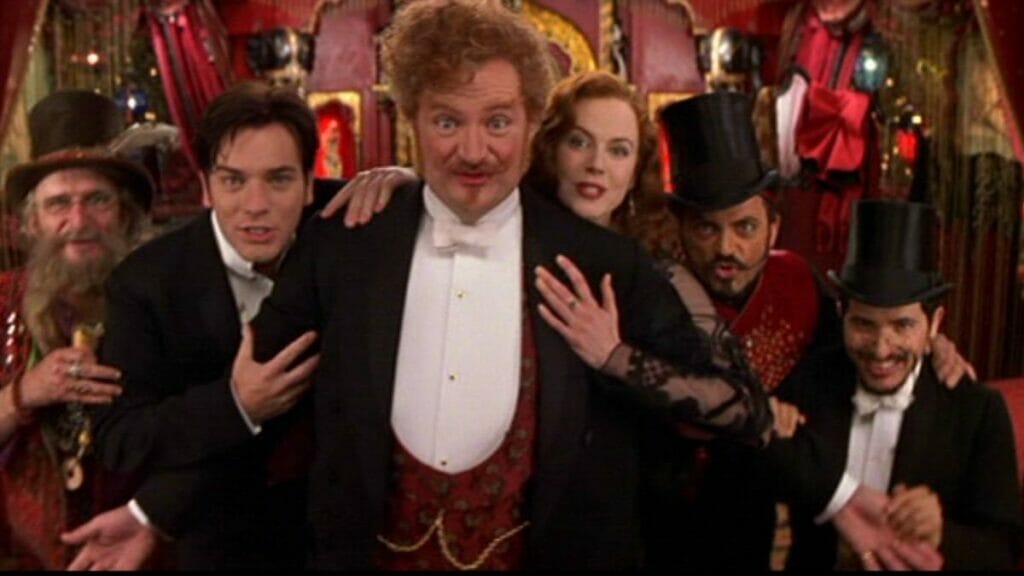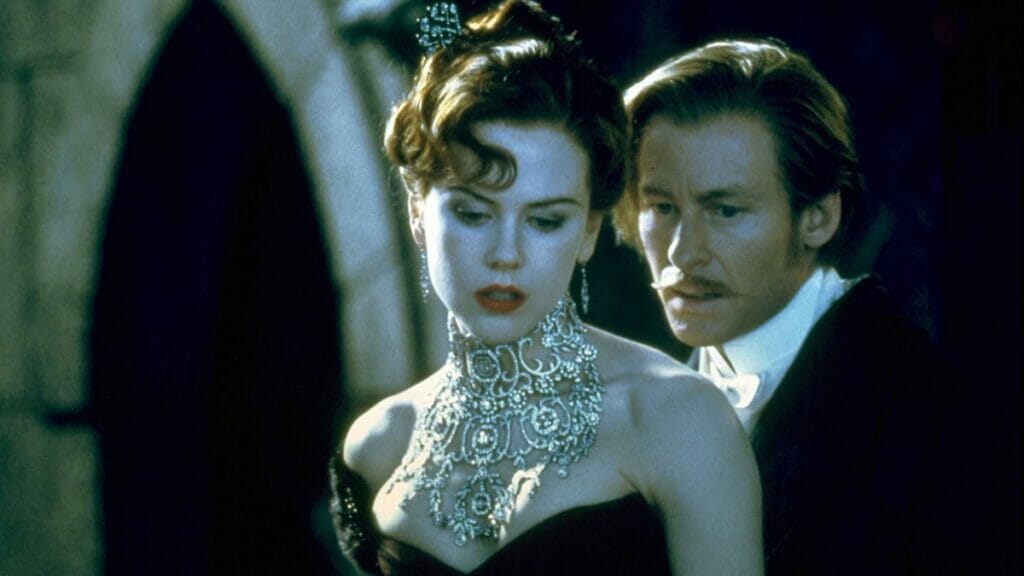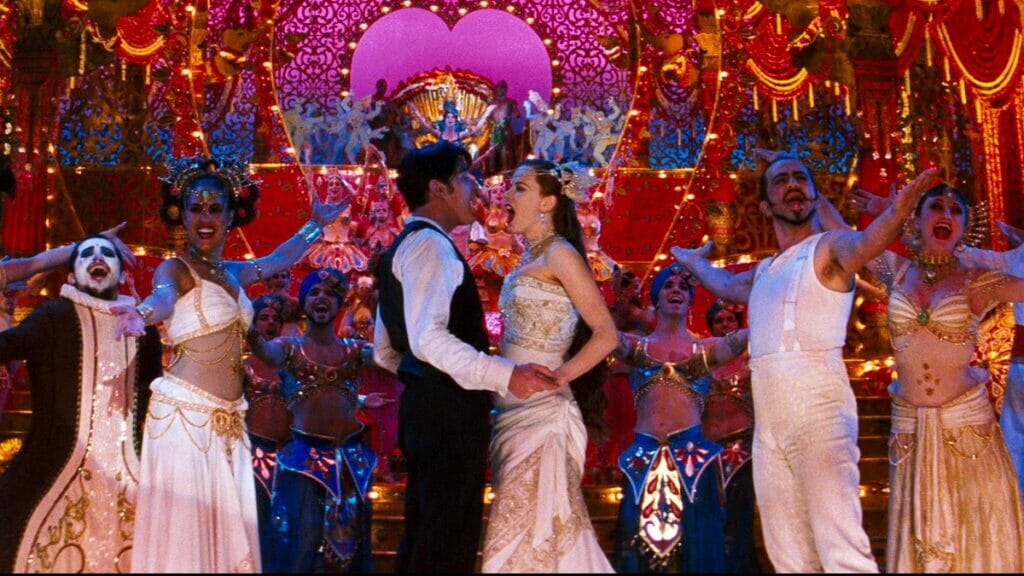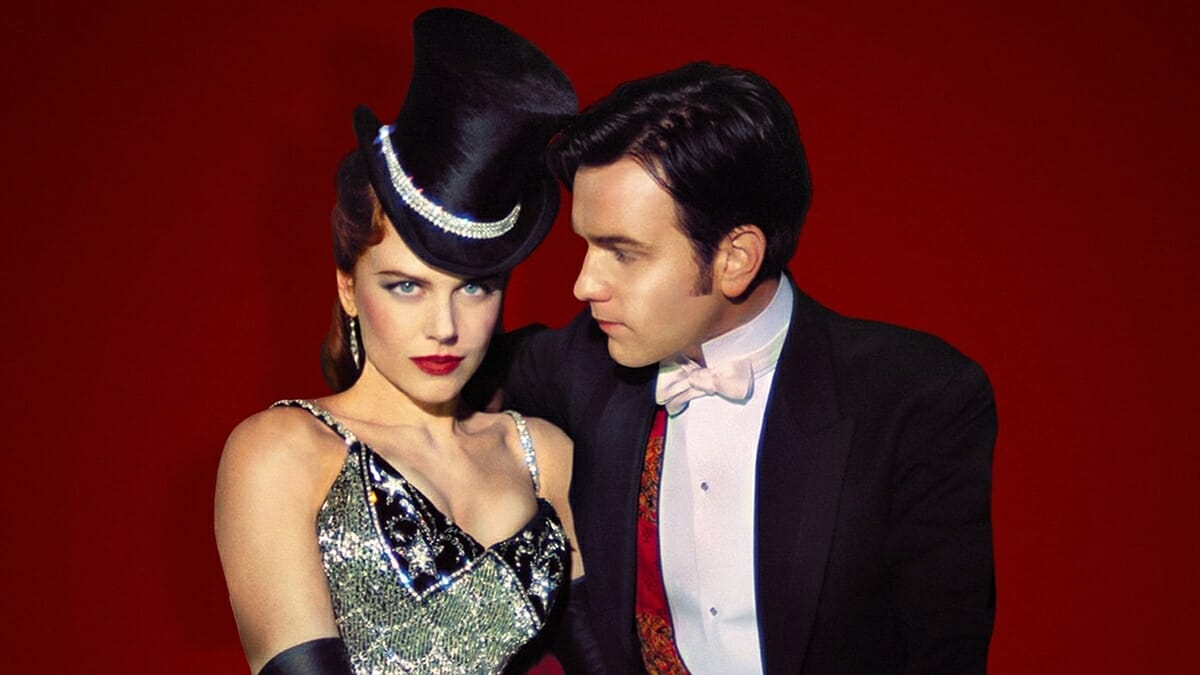Baz Luhrmann’s mashup musical piles on the spectacle on its way to embracing true love.

Every month, The Spool chooses to highlight a filmmaker whose works have made a distinct mark on the cinematic landscape.
Moulin Rouge! may be one of the most artificial films committed to celluloid. At every turn, it uses sound, color, setting, camera tricks, and good old-fashioned deception to create space between the audience and the material. And yet it ends up being as naked and guileless an ode to love as any movie of its era.
One only needs to wade five minutes into Moulin Rouge! to see how many layers deep Baz Luhrmann, directing from a script he co-wrote with frequent collaborator Craig Pearce, has buried the feature.
To begin with, the audience is either watching in a theatre or at home, the first stage of remove. Then, Luhrmann opens a conductor and a musical prelude. The curtain parts, placing the audience in a theatre, the second layer. Then the film’s first words are Toulouse-Lautrec (John Leguizamo) speaking in voiceover at some undisclosed point after the end of the story viewers are about to watch. Layer three.

As he speaks, the camera becomes the viewer, moving through the streets towards the Moulin Rouge, encountering the 19th Century equivalent of a street preacher and an addict. Next, the camera soars into a window, no longer human but still very much the audience. Leguizamo’s narration gives way to Christian’s (Ewan McGregor) voice, ostensibly reading his writing to the audience. This fourth layer also occurs after the film’s events, but presumably before Toulouse-Lautrec’s recounting. Finally, the audience “arrives” at the tale proper.
However, counter to what one might expect of multiple barriers, these obstructions pull the audience more deeply into the story. The initial distance makes the visceral pop of Moulin Rouge! that much more intense and destabilizing. The quick cuts, the overlapping, almost breathless dialogue often presented with heavy but unknowable accents, the colors, and the sense of a thousand stories you’ve already missed would likely overwhelm many without the journey Luhrmann took us on to get there. With all those obstructions, however, it instead achieves the hyperreal, a level of fiction so intense it pushes its way into reality.
[A]s naked and guileless an ode to love as any movie of its era.
The story itself is a familiar tale. Satine (Nicole Kidman, having a blast) is a showgirl and sex worker striving to one day be an actor. Poet Christian is the new arrival who immediately wows his bohemian neighbors, led by Leguizamo. They bring him on to write their show, devoted to truth, beauty, and above all else, love. This puts him in position to, through a classic Shakespearean bit of mistaken identity, meet the showgirl and fall in mutual love.
Unfortunately, the Duke (Richard Roxburgh), the man Satine intended to meet that night, has fallen into immediate infatuation with her. Without his money, the show can’t get made. Without the show, ringmaster/promoter Harold Zidler (Jim Broadbent) can’t turn the Moulin Rouge into a legitimate theatre. If Satine can’t perform in a legitimate theatre, she’ll never be able to leave behind the sexy dancing or sex for money. But she and Christian are so desperately in love. What can they do? Oh, and Satine has the consumption.

With the arrival of the plot, Moulin Rouge! takes on a general—albeit overcaffeinated—rhythm. Luhrmann, however, continues to push the artificial. While inside the Rouge or Christian’s apartment everything feels real and solid, everything outside dwells in the uncanny valley of compelling simulacrum. The overhead shots of 19th Century Paris are arresting, but they make no effort to look or feel authentic. Artificial appearances extend to several of the cast as well. Many never appear out of stage makeup. This includes Broadbent, who runs the Rouge, takes business meetings, and offers Satine counsel, always in full face–pale concealer, apple red cheeks, complimented by a mustache and soul patch so stylized as to be almost certainly glue-ons.
Taken in this light, one might include the music in this bundle of artifice. After all, it is entirely anachronistic. Unlike other jukebox musicals, there is no effort to conform to the classic versions of the songs or even to approach them. Instead, songs are mashed up with one another without any care for genre, era, or theme. And again, Luhrmann shows his cards and lets the audience in behind the curtain. As with when the story breaks through after the introduction, the music embraces the hyperreal. It doesn’t dedicate itself to one time period, artist, or genre because it is not looking to tap some kind of nostalgia. Instead, the songs are a tool for the director. Like his bohemian, he’s seeking truth, beauty, and love. The music is one vehicle to achieve that reality by springing forth from the artificial.
The initial distance makes the visceral pop of Moulin Rouge! that much more intense and destabilizing.
Finally, we arrive at the people. In Moulin Rouge!’s world, there exists hyperreal people and false people. The former are the heroes–Christian, the bohemians, Le Chocolat (Deobia Oparei), and Satine (eventually). Those who live falsely are often just background. However, those that embrace it become threats. The Duke, for example, outright pursues it. He demands at one point that Satine make him believe she loves him, knowing she doesn’t. He knows she’s in love with Christian. However, he’d rather dive deeper into lies than live honestly. The Duke prefers to force Satine to create a fiction than seek out someone who might genuinely care for him.
Kidman’s showgirl, however, is the best character to study to witness the contrast Luhrmann has built. As a performer and a sex worker, a certain amount of “faking it” is built into Satine’s life. She pantomimes flirtation and ecstasy as she performs. She does the same, with different emphases, with clients. However, in her meeting with Christian, before she realizes the mistaken identity, the performative nature of her interactions is next level. She writhes, moans, and screams as McGregor wonderfully stutters what reads like C-level poetry without the benefit of confidence and strong backing instruments. Her behavior is so wildly over the top, even amongst Moulin Rouge!’s excess, that it reads as ridiculous. And then Christian begins to sing.

Through song, Christian rocks Satine out of the artificial to join him in the world of the real and hyperreal. It is ludicrous she would, with stonefaced sincerity, declare her love for him after a song. But because of the intensity of artificiality around her and in the film’s world, it reads as wholly believable. Satine’s earnestness doesn’t play as dumb or naïve in the place Luhrmann has created. Because it contrasts so strongly with everything false, it’s easy to join her in that moment. To crack her façade, to shatter the status quo of fakery inherent to the environment, it would have to be powerfully honest, a moment of unimpeachable reality. We know what it looks like when she’s being false, so this has to be true.
It continues like that throughout. Luhrmann creates high contrast with the layers of artificiality. Thus what is honest in the film, even though it so often becomes huge and hyperreal, feels authentic. Rather than the artificiality creating distance, it helps the viewers immediately spot and embrace what the bohemians love so much: truth, beauty, and, above all, love.

